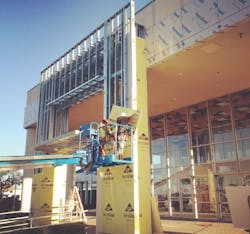Calculating the ROI of building enclosure commissioning
According to Evan Mills, PhD, a researcher at Lawrence Berkeley National Laboratory, building enclosure commissioning, or BECx, should be viewed as “the single-most cost-effective strategy for reducing energy, costs, and greenhouse gas emissions in buildings today.”
(This article excerpted from BD+C's June 2013 AIA/CES course on cladding and exterior insulation. Take this free course at BD+C University.)
Mills studied the benefits of BECx, noting that commissioning only costs about $1.16/sf for new construction and $0.30/sf for existing buildings on average, with a payback period of as little as 14 months. Savings associated with using BECx from both maintenance and energy savings average about 16% for existing buildings and 13% for new construction. The main benefit is that whole-building energy savings are guaranteed, thanks to the pivotal role of the enclosure in determining efficiency performance.
“Further enhancing the value of commissioning, its non-energy benefits surpass those of most other energy-management practices,” including major first-cost savings through right-sizing of HVAC equipment, Mills has testified. “When accounting for these benefits, the net median commissioning project cost was reduced by 49% on average, while in many cases they exceeded the direct value of the energy savings.”
The National Institute of Building Sciences published its NIBS Guideline 3-2012 on enclosure commissioning last year. The U.S. Green Building Council has allowed the application of BECx to earn an innovation credit in the LEED rating system, and BECx was even considered as a prerequisite, but that proposal lost momentum, says Rob Kistler, AIA, NCARB, Committee Chair for NIBS Guideline 3 and Principal, The Facade Group.
It appears that LEED v4 will not explicitly encourage the detail review, onsite testing, and observation that some enclosure experts say is what makes BECx effective, notes Tristan Roberts, with BuildingGreen’s LEEDUser service. Instead, the new LEED draft language directly quotes NIBS Guideline 3, which describes the following techniques as part of proper BECx for enhanced building commissioning:
• Devise a plan early in the project cycle that describes testing requirements, acceptance criteria, and documentation.
• Review details in the construction documentation to check for overall performance, continuity of weather barriers and insulation, and constructability.
• Conduct observations on the job site as required for critical milestones in enclosure installation, from field mockups to trades startup to field testing.
• Use mockups to benchmark workmanship requirements and ensure compliance with specifications and manufacturer’s installation requirements.
The NIBS committee for BECx, which Altenhofen serves on, recommends including a consulting enclosure expert for the building project, especially in the construction administration phase. The expert will help ensure proposed cladding materials and systems are integrated properly into the design process, followed by visual observations of a statistical sampling of installation of work. Toward the end of the CA phase and before acceptance, a blower-door test will check whether the air infiltration levels are equal to or better than standard.
As noted in the summary of NIBS Guideline 3, BECx helps reduce the chances that inadequate cladding work will be discovered during the punch list phase: “The performance of the enclosure cannot be verified until the entire building is completely enclosed. At this time it is not possible to tune or dial in the performance. To access a nonperforming subsystem or assembly might be very expensive.”
(This article excerpted from BD+C's June 2013 AIA/CES course on cladding and exterior insulation. Take this free course at BD+C University.)
Sign up for Building Design+Construction Newsletters
Get the latest news and updates.
